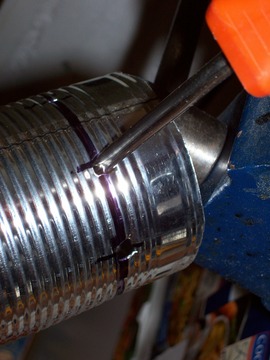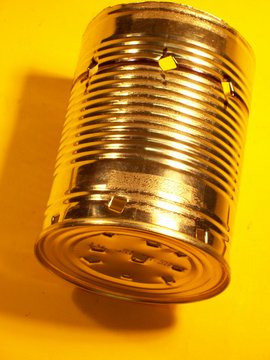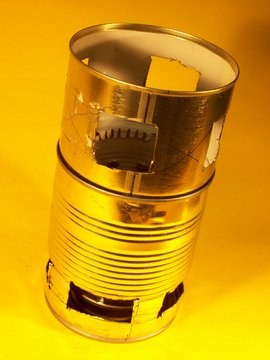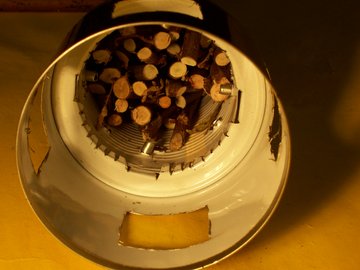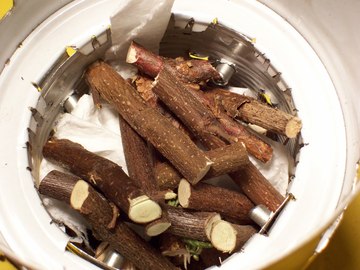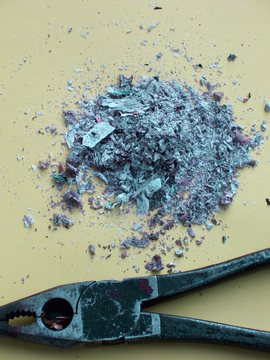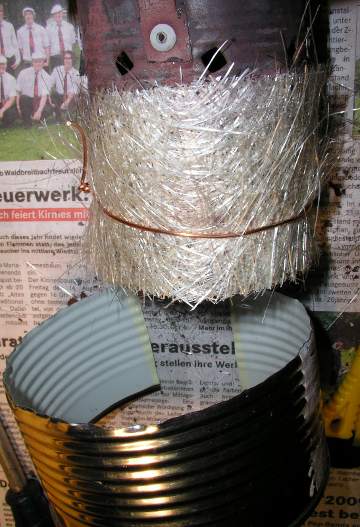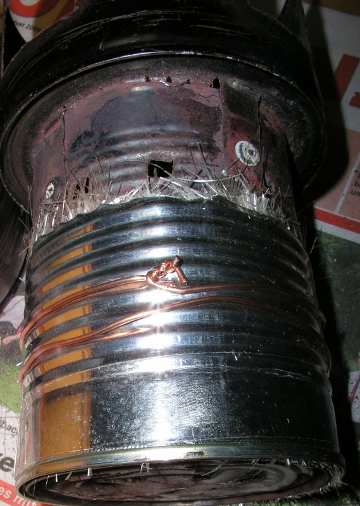Hauptseite Kocher: klick! |
Mainpage Outdoor Stoves: click here!
|
Camping-Kocher mit HolzNach dem Prinzip der HolzvergasungWas ist das Wesen des Woodgas Stove? Der Abbrand geschieht, abgesehen von den Sekunden
des Anzündens, nicht dort, wo das Holz ist, sondern im
obersten Bereich der Brennkammer, wo aus einem Kranz
von Löchern vorgewärmte Außenluft aus der Doppelwand
hineingeleitet wird. Die Strahlungswärme aus dem
oberen Flammenring bringt das Holz unten zum Glimmen,
sodass Kohlenmonoxyd und andere brennbare Gase
austreten (Holzvergasung) und nur noch Holzkohle übrig
bleibt. Auf Youtube sieht man immer öfter, wie ein
Holzvergaserofen falsch befüllt und bedient wird. In
dem folgenden Link wird Klarheit geschaffen, sehr
sehenswert: https://www.youtube.com/watch?v=h8AqZ0OXhA4
oder https://www.youtube.com/watch?v=ZQrjraiPOw0
(sorry, German only). Es fing damit an, daß mein kleiner Gas-Kocher, den ich
für Stromausfälle seit Jahren in Reserve habe,
kaputtging. Die Lösung war ein Spirituskocher. 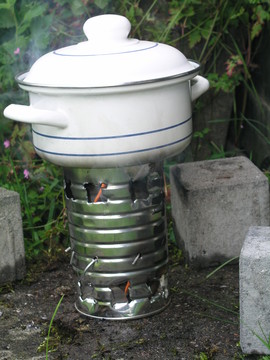 Neuerdings sind aber weitere
Untersuchungen gemacht worden, die vor allem im
Zusammenhang mit dem Energiebedarf in holzarmen
Entwicklungsländern Beachtung finden (PDF
von Biomass Energy Foundation). Hierbei hat sich ein
neues Prinzip herauskristallisiert, das Kochen mit
Holzvergasung (Suchwort "woodgas-stove"). Der Garlington Woodgas Stove von 2003 ist noch nicht perfekt. Auf http://www.backpackinglight.com/cgi-bin/backpackinglight/xdpy/forum_thread/10020/index.html?skip_to_post=87736 schrieb Andrew Wilson in seinem Posting vom 15.2.2008, man müsse die Primärluft verringern und die Sekundärluftzuführung erhöhen. Außerdem fand ich die Bauweise diverser Bastellösungen unpraktisch, oder Material und Werkzeug waren für mich schwer erhältlich. Daher kommt nachstehend meine erfolgreich erprobte Anleitung. Zum Vergrößern Bilder anklicken! |
Outdoor Woodgas StoveTLUD ("Top Lit Updraft Gasifier")What is the difference between a Hobo Stove and a TLUD? The wood is not burning at all, except in the few seconds after lighting it. The flames are where the air is sucked from between the double walls through a ring of holes, at the very top of the burning chamber. The radiant heat from the ring of flames from above makes the embers down in the burning chamber emit carbon monoxide and other combustible gases, so at the end there only is some charcoal leftover. When my gas stove broke, which I had in reserve at my home, I decided gas was too dangerous to be kept inside the house. An alcohol burner followed. While searching for the solution, I found descriptions of wood stoves which fascinated me. I knew that with 0,008 ltr. alcohole I could warm a meal, but never in my dreams I thought that the same energy is contained in a handful of wood pellets. One kilogram of wood has approx. the same energy as 0.4 ltr. alcohole. Wood burners are known in US as "Hobo cookers", simply made out of an old tin can - cut holes near the bottom and the top, put a grid for the wood above the lower holes, ready für use. I found the performance of my first experiment not satisfactorily (see left pic). New researches have brought a new principle, important for developing countries with need of wood (see PDF, link from Biomass Energy Foundation). These burners are based on the woodgas principle: do not burn wood, heat it until it is cracked into methan and other gases and burn the gases - without soot, without fume, and using more of the energy contained. The fire is started on the upside and eats it's way downward. Most of the wood is not burnt in direct contact with air, but gasified and the gas is burnt in the upper part of the burner ("inverted downdraft gasifier"). You can buy stoves built to this principle, with a
forced air supply, needing batteries: (http://www.woodgascampstove.com/). The Garlington Woodgas Stove from 2003 is not yet perfect. In the forum http://www.backpackinglight.com/cgi-bin/backpackinglight/xdpy/forum_thread/10020/index.html?skip_to_post=87736 Andrew Wilson in his posting from said the primary air was too much, the secondary air too sparse, and it was made of materials I did not have. Furthermore I found easier ways to build the stove and some of the cans mentioned in the instructions were not usually found here in europe. So find herafter my construktion, "Mark II", tested successfully! Click on pics for details. |
|
Das ist alles, was man an Material
braucht: je eine von den gängigen Konservendosen
(Fertiggericht, Suppe oder Gemüsekonserve, typische
Gulaschkonserve von gleichem Durchmesser wie das
Fertiggericht - Dosen sind stapelbar gefertigt und die
beiden größeren passen also auch für unser Projekt
genau ineinander).
|
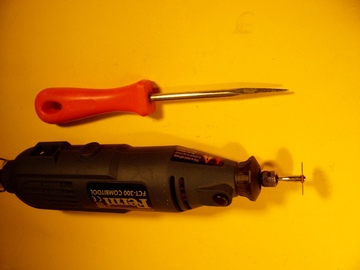 Dies sind die wichtigsten Werkzeuge, die ich genommen hatte: Ein Instrument zum Stechen von Löchern, das man sich auch leicht aus einem ausgedienten Schraubenzieher schleifen kann, und ein Dremel bzw. Bauähnliche mit einer Mini-Trennscheibe. Wie weiter unten gezeigt wird, kann Konservendosenblech auch noch mit einem Teppichmesser geschnitten werden. I did use these tools, among others: one instrument for making holes, one Dremel or similar with rotating cutting disk.You can do with others, like cutting knife, drill etc. |
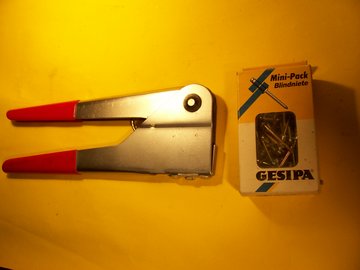 Für die Verbindung des Brenners und des Topfstandes habe ich Nieten gewählt. Schrauben oder Blechschrauben würden natürlich auch gehen, oder man zieht die Befestigungslaschen durch Schlitze und bördelt sie um. To connect the pot stand to the combustion chamber, I used rivets. Screws would have done the job as well, or fasten the connection strips in slots. |
Zuerst wird der Umfang der kleinen Dose auf dem Boden der niedrigen (Gulasch-)Dose angezeichnet. First draw a line around the smallest
can on the bottom of the meat can (the short one, 74mm
height). |
|
Ein Kreuz mit dem Lineal nach Augenmaß zeichnet die Mitte für den Topfständer an. Make a cross to find the Center of the
pot stand. |
Die künftigen Befestigungslaschen werden nach Augenmaß angezeichnet. Sketch what will be the metal tongues
bent down and used for connecting the pot stand to the
combustion chamber. |
 In die Befestigungslaschen werden die Löcher für die Nieten gestochen, solange der Boden noch ganz ist und daher stabil für eine Bearbeitung. Es wäre wichtig gewesen, gleich jetzt die Löcher noch auf die genaue Größe der Nieten aufzuweiten. Make holes into what will be metal tongues. Make them the exact diameter now, when the bottom of the can is still stable. |
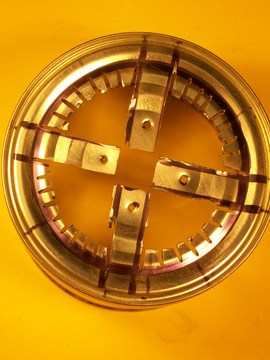 Hier sind die überflüssigen Teile des Bodens schon mit dem Dremel herausgeschnitten, die Laschen ausgearbeitet und ein Rand zum Umbördeln gemacht, damit der Brenner wirklich dicht wird. Cut out the tongues and most of the
bottom of the pot stand, leaving a rim which will be
bent into the combustion chamber later. |
|
Der Topfstand erhält die Löcher für die
Abluft, hier sind die Umrisse schon eingeschnitten. Make four big holes into the pot stand.
Here they are cut but not yet broken out. In the
meantime I made them smaller, about
one third, situated near the upper rim. |
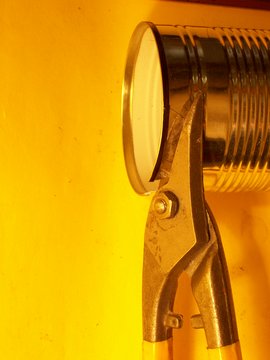 Die kleinere Dose, der Brenner, ist fast so hoch wie die große. Es muß aber unten ein Raum für den Eintritt der Primärluft bleiben, also habe ich die kleinere Dose oben mit einer Blechschere um ca. 12 mm gekürzt. My smallest can, the combustion chamber, seemed way too high so I cut off approx. 12mm. |
|
Jetzt sind am oberen Ende der kleineren Dose 8 Löcher am Umfang für die Sekundärluft zu stechen. Das ist eine schwierige Aufgabe, weil man beim Stechen die Dose plattdrücken würde, bevor das Werkzeug durchgeht. Daher wird die Dose aufgestützt, hier einfach auf der Achse eines Schraubstockes. Now make eight holes into the combustion
chamber, approx. 75mm from it's bottom. It is very
difficult to stitch the holes without deforming the
can, so you see I rested it's inside on a prominent
part of my machine vice. |
Oben in ca. 75 mm Höhe sind die acht Löcher für die Sekundärluft gestochen, unten acht Löcher am Umfang und neun Löcher im Boden für die Primärluft. Das ist aber zu viel Primärluftzufuhr, inzwischen hat die Dose nur noch fünf Löcher auf der Unterseite und gar keine mehr an der Seite. So brennt nicht in den allerersten Minuten alles aus. Die Holzkohle glimmt am Schluß kaum noch und wenn man sie in eine Dose mit Deckel ohne Luftzufuhr schüttet, kann man sie für später noch aufheben. Heath Putnam hat auf Youtube vorgeschlagen, die Sekundärluft-Löcher mit einem spitzen Instrument noch alle in einer Richtung zu verformen, sodaß die Flamme einen Wirbel bildet, anstatt sich gegen die Flamme aus dem Loch gegenüber zu stauen. Auf dem folgenden Link sind die Löcher nur winzig: (Klick) (von dieser Webseite). See the eight holes on the top area of the combustion chamber, another eight holes around it's diameter near the bottom and a further nine holes. Heath Putnam proposed on Youtube to form the outlets for the secondary air all in one direction with an round instsrument with a sharp point, to have a vortex, instead of blowing the flame from one hole against that on the opposite one. My original primairy air inlets proved
too much, in the meantime I closed those on
the side and only left five ones in the bottom.
With them the woodgas will burn very well but not as
fiercely in the first few minutes as was the case with
too many holes. The remaining coal, which does not
contribute to the heating of the pot because the
distance is too great, will stop to glow and, if put
into a can without air flow, can be collected for
later use. |
|
Bend the metal tongues downwards and bolt them to the outside of the combustion chamber with rivets. Mark the position of the rivet holes very exactly and make sure the parts do fit together closely. The tongues/strips are on the outside of the smaller can, the rim is bent down on the inside, as you can see in the next picture. See the holes for secondary air in this picture, too. |
Hier ist der Brenner schon mit dem
Topfständer zusammengenietet, der später die
Doppelwandkonstruktion oben abschließt. Man sieht die
vier Befestigungsnieten nach innen herausstehen. Auf
gleicher Höhe sind acht Löcher für die Sekundärluft
gestochen. Nächstesmal würde ich die Auslass-Öffnungen
oben kleiner machen und evtl. als Kranz unmittelbar
unter dem Topfboden bohren. Durch die jetzigen großen
Öffnungen wird schon mal die obere Flamme bei Wind
ausgepustet und man muß in die Glut blasen, um sie
wieder anzufachen. Außerdem geht wohl eine Menge Wärme
verloren. Maybe next time I'll try to do the construction without rivets or screws - cut vertical slits into the combustion chamber tin can at the top (instead of making the slits at the bottom of the pot stand), not of shortening the combustion chamber tin can, and bend every second of the resulting tongues below the pot stand outwards, stick the other half of them through the opening and bend them outwards, too. All of them together should keep the construction together as stable as the four rivets, alternatively one below and one above the bottom of the pot stand. In the picture you see the construction
for the first time. On top there is the pot stand with
the holes letting out the hot gases. (Next time I will
drill smaller holes and place them higher, near to the
bottom of the pot). Two of the four rivets are visible
on the pic inside the burner, and the secondary air
inlets, which are at approx. the same height. At the
very bottom of the combustion chamber you see the
holes for primary air. |
|
Der Brenner und der Topfstand werden in den Außentopf eingesteckt werden. Hier werden gerade mit einem Teppichmesser die Luftlöcher unten in den Außentopf gemacht. Ich habe vier Rechtecke von Hand angezeichnet, jede der Ecken durchstochen und das Rechteck mit einem Teppichmesser ausgeschnitten. Die zwei unteren Abbruchklingen des Teppichmesser sind natürlich hinterher ruiniert, aber das Metall lässt sich gut damit schneiden. Wenn man einen Pfahl oder sonstigen Holzkern für die Dosen findet, kann man sicher die ganzen Öffnungen auch ohne Dremel sauber hinkriegen, ohne die Kanten oder die ganze Dose einwärts zu biegen. Here you see the holes at the bottom of
the outer can are cut with an ordinary carpet knife.
You might cut all the holes cleanly without a "Dremel"
if you find a cylinder (pole) of wood which fits well
into each of the tin can, to prevent deforming it
while applying pressure for cutting. |
See the whole construction. It's now clear. The air inlets are at the bottom of the outer can. The air stream splits: one part, the primary air, enters through the holes at the bottom of the combustion chamber, the other part, the secondary air, is streaming upwards and enters at the top of the combustion chamber. The primary air must not be too much; it is only for burning a small part of the wood content, to give the heat for gasification. The secondary air ist for burning the wood gas produced by heating the wood. |
 Von oben: der Topfstand; die Nieten, mit denen der Brenner befestigt ist; auf derselben Höhe wie die Nieten die acht Sekundärluftlöcher, durch die über (!) dem Feuer der Sauerstoff zugeleitet wird; ganz unten der Brennraum mit seinen Primärluft-Löchern. Here's the inside of the whole construction. |
 Hier das Ganze mit aufgesetztem Kochtopf. Unten sieht man das doppelwandige Prinzip, der Brenner hängt unten am aufgesetztem Topfständer und erscheint gerade hinter den Lufteintrittslöchern unten. The pot fits well and is stable on the pot stand. The pot stand rests on top of the outer casing. The combustion chamber is inside the outer casing, riveted to the bottom of the pot stand. |
|
Der Augenblick der Wahrheit kommt. Ich habe den Brenner mit Topfstand auf die Seite gelegt und die "Pellets", Holzstückchen von Bleistiftstärke, aufrecht stehend so dicht wie möglich unten eingelegt. Dieser Teil der Füllung ist zur Vergasung vorgesehen. I filled the combustion chamber with
wood pellets packed tightly, standing upright. This is
the lower content, which will be gasified by heat from
above. |
Darüber ein Stück Papier (aber keine dichte Lage, die noch als Asche den Weiterbrand verhindert), in Spiritus getränkt, oder z.B. ein wachsgetränkter Fidibus und "zeltförmig" weitere Pellets. Inzwischen kommt auch Kienspan zum Einsatz, den es z.B. auf http://www.brennholz-perfekt.de/anzuendhilfen/ (ausprobiert, guter Kundendienst, das Holz kommt aus Nordamerika, und ab vier Kilogramm kommt in seinem Webshop der billigere Preis heraus) oder https://shop.diepreisjaeger.de(/product_info.php?info=p65_2-kg-kienspaene-natuerlicher-holzanzuender-ofenanzuender-ca--20-cm-lang.html (angefragt, antworten schnell, deren Holz kommt aus Südamerika) zum Kilopreis ungefähr von Aldi-Tiefkühlsteak zu kaufen gibt (das ist billig, Waldläufer können mit abgeraspeltem Zunder davon ein Jahr lang Feuer anmachen).
Die richtige Füllung ist entscheidend
für den Erfolg. Der Ratschlag, oben nur ca. 2mm
leichte Holzstücke zu verwenden, ist m.E. nicht
erfolgversprechend. Mir sind bei dem Modell Mark1 oft
die dünnen Hölzer abgebrannt, ohne genug Energie zu
erzeugen, um den Hauptvorrat zu entzünden und von oben
nach unten durchbrennen zu lassen.
Here's a piece of
methylalcohole-drenched paper packed on top of the
lower content (but only on a part of the diameter),
and some pellets placed above forming something like a
tipi (thanks to atman and to Mark Jurey, http://www.csun.edu/~mjurey/pennywood.html,
for their great instructions!), for starting the fire.
Some paper drenched in wax are also good for starting
the fire. Do not use very thin pellets for the above
part; it might burn down without having supplied
sufficient heat to start gasification. |
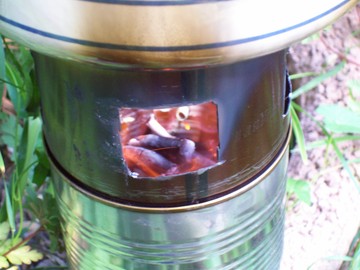 Nachdem auch die stärkeren Holzstücke der oberen Lage richtig brennen, setze ich beruhigt den Topf auf. Der Holzvorrat brennt jedenfalls, und nach 2...3 Minuten ist der Topfinhalt schon am Kochen. After I saw that the biggest pellet on
the upper layer (the starter fire) are burníng, I
placed my kitchen pot on the pot stand. |
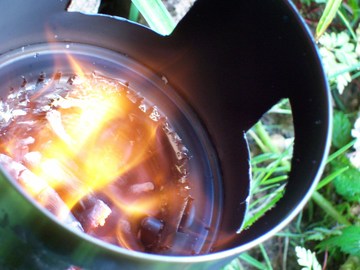 Blick in den Brenner, nachdem die oberste Lage abgebrannt ist und den Hauptvorrat entzündet hat. That's how it is looking like after the starter fire on top has ignited the main content and started the gasification. |
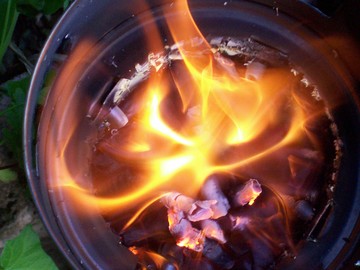 Erfolg! Die rauchlose Flamme sah ich eindeutig nicht aus dem Holzvorrat kommen, der nur vor sich hinglimmt, sondern wie bei einem Gasherd aus den luv-seitigen Sekundärluft-Löchern. Hier tritt natürlich nicht das Holzgas aus, sondern der Luftsauerstoff aus der stark vorgeheizten Sekundärluft, der dieses zum Brennen bringt. Here is the proof: the flame does not
come from the wood pellets, but from the eight
secondary air inlets. It is not wood gas that is
coming out of the inlets; it is the oxygen of the
strongly pre-heated secondary air which is igniting
the wood gas streaming upwards from the glowing wood
pellets. |
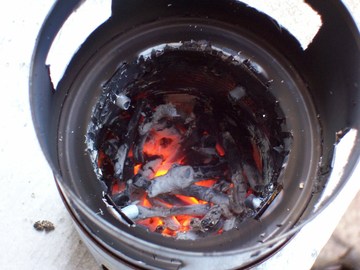 Nach ein paar Minuten ist die Gasproduktion zu Ende. In diesen Minuten hat der Brenner intensive Wärme abgestrahlt. Jetzt glimmt nur noch etwas produzierte Holzkohle. Some minutes later the wood gas production has ended. Now only some charcoal is glowing intensively at the bottom of the burner. |
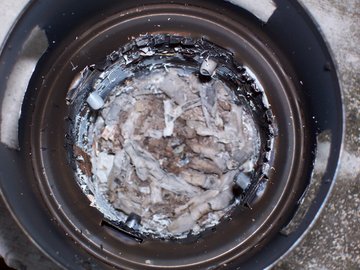 So sieht der Inhalt nach dem Erlöschen
aus. Der Konstruktionsvorteil bei meinem Modell MarkII
ist die leichte Reinigung: einfach Topfstand samt
dranhängendem Brenner aus dem Umtopf nehmen und
ausleeren. Auch wird der Untergrund nicht verbrannt;
nach intensivem Abbrand konnte ich den Brenner mit dem
glühenden Inhalt für einen Augenblick am Boden mit der
Hand festhalten, ohne mich zu verletzten. That's the combustion chamber after burning all wood pellets. One of the advantages of my Mark II construction is that you can empty it easily. Another one is that the residues will be contained in the burner and the outer can. The stove will not burn the ground; I even could hold the bottom in my hand after a full burning session for a moment, without hurting myself. The trick is not, that there is wood gas distilled out of the wood pellets. This is, to some degree, the case in every campfire. The trick is that there is fresh, hot air (oxygen) is blown directly into the concentrated wood gas. |
Übrig bleibt von der ganzen Holzfüllung
nur ein weißes Aschenhäufchen. Das Gewicht habe ich
mit einer Briefwaage auf mehr als zwei Gramm, weniger
als drei Gramm bestimmt. Die Energieausnutzung in
einem Holzgasbrenner ist fast doppelt so hoch wie bei
einem offenen Holzfeuer. Thats what remains of fourty to fifty 5cm wood pellets: fine, white ashes, less than three grams. The wood is used up totally. The efficiency factor of this type of woodgas burner is said to be almost twice of that of an usual wood fire. The pair of pliers is good for making
the pellets and for handling the hot stove. |
|
Und der praktische Nutzen von der ganzen Sache? Nun,
mit dem beschriebenen Teil kann man dasselbe machen
wie mit einem Esbit-Kocher: Wasser und Speisen
erwärmen. Eine halbe Stunde Kartoffeln oder Reis
kochen ist nicht drin. Ohne zivilisatorische
Ressourcen kommt man ebenfalls nicht aus, denn man muß
zumindest Feuer machen können und braucht
vorzugsweise Trocken-, Gel- oder normalen Spiritus für
einen sicheren und qualmfreien Start. Das Zerkleinern
von Astholz zu Pellets bringt viel Arbeit mit sich,
wenn ich es auch eher als meditative Beschäftigung
denn als lästige Pflicht ansehe. Man mag sich überlegen, ob man sich die Ausgabe für einen kommerziellen Brenner, dann aus Edelstahl und mit künstlicher Luftzuführung, machen will oder dann doch etwa einen Spiritus-Brenner a la Trangia praktischer findet. Benutzt die Dinger bloß nicht in geschlossenen Räumen - sie sind konstruiert, tödliches Kohlenmonoxydgas zu produzieren und wenn's nicht plangemäß verbrannt wird, seid Ihr tot (oder Eure Lieben)! |
Now what is the use of the whole thing? You can do
the same as with an Esbit Cooker (Esbit is in Europe
called "Dry-Alcohole", easy to use but quite
expensive): heat Meals. With my Woodgas Stove you can
not cook potatoes or rice, the fire won't burn the
needed time. (Maybe regulating the primary air would
help). To collect and cut the pellets you need time.
You will need ressources like matches and alcohole or
oil to start the fire. After having tested the woodgas-stove you are better qualified to decide if you prefer to buy a commercially-made stove of stainless steel with forced air supply or maybe go back to a trangia-type methylene burner. Never use wood burning stoves in closed rooms - they are constructed to produce potentially deadly carbon monoxyde and if they are not burning the gas as intended, you will be dead - or your kids! |
|
Verbesserung/Improvement: Jemand hat in einer Bauanleitung für einen ähnlichen, aber einwandigen Kocher erwähnt, daß bei ihm die Holzvergasung erst in Gang kommt, wenn er eine Wärmeisolierung am Brenner installiert. Ich habe dies zum Ausprobieren mit einer dünnen Lage Glasfaservlies für die Autoreparatur realisiert (oben, mit einem Kupferdraht gehalten). Somebody mentioned in an instruction for building a similar but not double-wall stove, that he only had success in producing woodgas when isolating the combustion chamber. I wanted to try out if this would further improve the MarkII Stove. Here's some fibre glass fleece from car repair materials, hold by a copper wire. |
Außen um das Glasfasergewebe wurde eine Lage Blech mit Kupferdraht befestigt. Es blieb immer noch genug Abstand, damit die Sekundärluft in dem Zwischenraum nach oben steigen kann. I fastened another layer of metal cut out from a tin can round the fibre glass fleece. There was left room enough so the primary air still can flow to the upper inlets. Tatsächlich wurde der Vorrat an Holzpellets im unteren Bereich jetzt unerreicht problemlos zum Glühen gebracht und die Holzgasproduktion, erkennbar an den Flammen ab der oberen (sekundären) Luftzuführung, begann praktisch sofort. Indeed the wood gas production started faster after setting some tinders on fire on top of the pellets and there was no more problem getting the wood pellets in the lower part to smolder. |
|
Wie geht es weiter? Ich denke intensiv darüber nach. Bei Ebay und, noch besser, über Kleinanzeigen sind mit den Suchworten "weissbleich eimer" Gefäße um 230 Millimeter Durchmesser ab 6 Liter erhältlich, als "weissblech dosen" bis 2.5 Liter/140mm Durchmesser. Auf http://www.el-carbonero.de//index.php/bauplan.html gibt's eine Anleitung für einen großen und standsicheren Brenner daraus. Alternativ findet man unter "Rauchrohr" Ofenrohre bis um 20 Zentimeter. Mit "spargeltopf" gibt es Gefäße von 17-18 Zentimeter Durchmesser , gut als Außengefäß für einen kleinen oder als Brenner für einen großen TLUD-Ofen. Next model? I am considering a larger TLUD burner. Material could be from a tinplate bucket (they have approx. 230mm dia.) and an aspargus cooking pot (app. 170mm dia). As an alternative, there is available a large selection of stovepipes, some of them double-walled... |
URL: http://hannes-birnbacher.de/interessen/outdoor/woodgas-stove.html
Kurz-URL (short URL of this page): http://tinyurl.com/ls8zdf
Zurück zu "Interessen"





